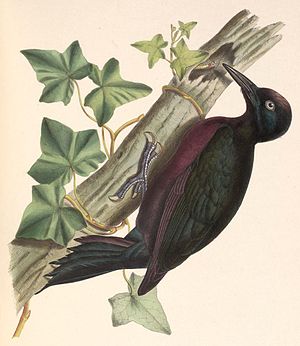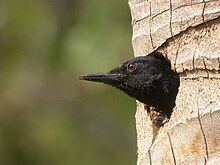Guadeloupe woodpecker
| Guadeloupe woodpecker | ||||||||||
|---|---|---|---|---|---|---|---|---|---|---|

Guadeloupe woodpecker ( Melanerpes herminieri ) |
||||||||||
| Systematics | ||||||||||
|
||||||||||
| Scientific name | ||||||||||
| Melanerpes herminieri | ||||||||||
| ( Lesson , 1830) |
The Guadeloupe Woodpecker ( Melanerpes herminieri ) is a species of bird from the family of woodpeckers (Picidae). This very small species of woodpecker is endemic to the islands of Guadeloupe in the Caribbean and inhabits a wide range of mostly moist forest communities there. The food that is mainly sought on trunks and thicker branches consists mainly of beetle larvae, but also of other insects, small vertebrates and fruits. The Guadeloupe woodpecker is common, but is classified by the IUCN as a type of the warning list ("near threatened") due to its very small distribution area and the ongoing habitat destruction .
description
Guadeloupe woodpeckers are quite small woodpeckers with a long, pointed beak that is narrow at the base. The ridge of the beak is slightly bent downwards. The body length is about 24 cm and the weight 87-100 g; they are about the size of a great spotted woodpecker , but much heavier. In contrast to many other woodpecker species, the species shows no sexual dimorphism in terms of coloration, but females are slightly smaller than males and have a significantly shorter beak.
Overall, the animals are very monochrome and dark in color and, in contrast to almost all other woodpecker species, do not have any noticeable head markings. The head and the entire top including the wings are solid black with a blue sheen. The inner flags of the hand wings and the control springs are dull and more brown-black. The entire underside is predominantly soot-black, only the underside of the trunk is covered with a dark red tinge from the throat to the belly by appropriately colored feather tips. Young birds are generally even darker and less shiny, the underside of the trunk is more reddish orange tinged. The beak is blackish, legs and toes are blue-black. The iris is deep brown. The intraspecies variability is very low and no subspecies are recognized.
distribution and habitat
The Guadeloupe woodpecker is endemic to the islands of Guadeloupe in the Caribbean and is the only species of woodpecker here. The size of the total distribution area is estimated at only about 1500 km². The species inhabits a wide range of mostly moist forest communities, including partially deciduous forests, evergreen forests, swamp forests and mangroves . The animals occur from sea level to the tree line at an altitude of 1000 m, but are most common between 100 and 700 m.
Way of life
Food is sought in trees, especially on trunks and thick branches, and when looking for fruit in the treetops. These woodpeckers mainly eat beetle larvae, but also other insects, small vertebrates and fruits. The food is read off, taken from small cavities or reached by lightly chopping; when eating fruit, the animals often hang upside down. The nest holes are created in the trunks of dead trees; further information on the breeding biology is not yet available.
Existence and endangerment
The population of the species on the two main islands of Guadeloupe is well known. On the 381 km² large island of Basse-Terre 7,920 pairs were recorded at the end of the 1990s, on the 135 km² large island of Grande-Terre 2410 pairs; so the species is common there. The population is declining, however, the main cause of the decline is habitat destruction through clear cutting and the removal of dead trees, further habitat losses are caused by hurricanes, road construction, airport expansion and land development. The predation of clutches and nestlings by introduced rats may also have a negative influence on the species. However, the population is not yet fragmented. The Guadeloupe woodpecker is classified by the IUCN as a type of the warning list ("near threatened") due to its very small distribution area and the ongoing habitat destruction .
swell
Individual evidence
- ↑ Melanerpes herminieri in the endangered Red List species the IUCN 2011. Posted by: BirdLife International, 2008. Accessed November 13, 2011th
literature
- Hans Winkler , David A. Christie and David Nurney: Woodpeckers. A Guide to the Woodpeckers, Piculets, and Wrynecks of the World. Pica Press, Robertsbridge 1995, ISBN 0-395-72043-5 , pp. 54-55 and 196-197.
Web links
- Melanerpes herminieri in the endangered Red List species the IUCN 2009. Posted by: BirdLife International, 2008. Accessed on 10 February, 2010.
- Videos, photos and sound recordings of Melanerpes herminieri in the Internet Bird Collection , accessed February 11, 2010
